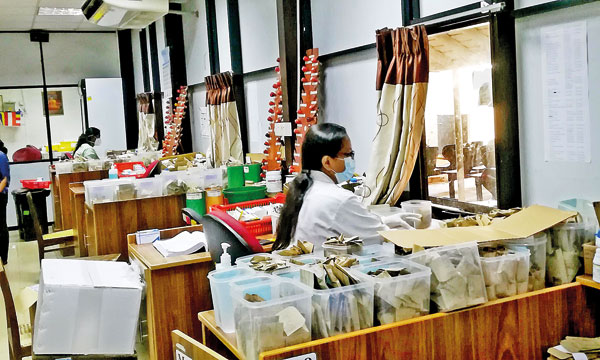News
Health Ministry scrambles emergency plans to deal with drug shortage
Health authorities are scrambling emergency plans to overcome the medicinal drugs shortage brought about by the worsening economic crisis, with some hospitals warning that they have only a few days of stocks of life-saving medicines such as the drugs used in the treatment of rabies.
As part of its emergency measures, the Health Ministry has decided to implement a mechanism, according to which buffer stock medicines in primary health care units and divisional hospitals will be brought to a central unit to be distributed on the basis of a need assessment, the Sunday Times learns.
The shortage was caused by a disruption in supply chains and distribution networks and delays in opening letters of credit (LCs) for want of foreign exchange. As a result, the ministry was unable to place orders for regular imports as it had done before the crisis.

Drugs being dispensed at the National Hospital. Pic by Nilan Maligaspe
Health Minister Keheliya Rambukwella has said the shortage of certain medicinal drugs would continue until such time the ministry receives US$ 400 million in World Bank aid to buy medicine. But he has estimated that it would take two months to sort out the crisis.
The World Bank, in a statement on Tuesday, said it would not offer any fresh credit to cash-strapped Sri Lanka until an acceptable economic policy framework was in place.
However, the Bank said it was repurposing funds from previously approved projects to assist the Government in paying for necessary medicines, interim cash transfers to poor and vulnerable households, and other assistance.
“It will take around two months to procure the drugs using relevant funds, and there will be a shortage throughout the country until then. To maintain the gap, we want surplus medicines in the stores to be transported to a central location, leaving minimum stocks at appropriate health care units,” Minister Rambukwella said. He said the ministry was taking stocks of medicine at hand to prepare a database.
In the meantime, the Government is also receiving private donations. On Thursday, the Health Ministry received 300,000 Euros worth of anaesthetic drugs from France.
This week, it was revealed that the present stock of anaesthetic medicines required for surgeries would barely last 90 days.
A senior medical officer attached to a primary health care unit at Balangoda said the unit had not faced a drug shortage problem yet. “The central government has requested us to send back whatever surplus stock we have. We have a buffer stock enough for three months. We are returning most of the excess medicines, especially antibiotics and paracetamol, to the government, while keeping with us a stock to meet our requirement for one month,” he said.
The Puttalam-Marawila divisional hospital, too, is returning extra stocks to the central unit. However, a senior medical official said the hospital was facing a shortage of oral-antibiotics drugs for child patients.
“Colombo National Hospital doctors have already started regulating the usage of paracetamol and surgical consumables such as gloves, gowns, masks, syringes and gauze. We are sending back surgical consumables in our stock to the ministry,” the officer said.
Some clinical drugs are already in short supply at the four divisional hospitals in the Gampola area.
“Clinical medications used to treat high blood pressure are already scarce. Antibiotic syrups for toddlers and inhalers are also unavailable. Cotton is likewise in short supply. So are surgical medications. These are the primary items in short supply. However, acute management drugs are available for a few months,” Gampola Divisional Hospital Medical Officer Dr Amila Panagala said.
At the Medawachchiya Base Hospital, a key centre that treats the Chronic Kidney Disease (CKD), dialyses are continuing on a daily basis. The hospital, however, has issued a warning, saying medicines are fast running out and it could manage treatment for kidney patients only for two months, if the stocks are not replenished.
A hospital official confirmed that the ministry had requested details of extra drugs. “The ministry wants to know the stocks in our possession,” he said, adding that a list was being prepared.
At the Colombo South Hospital (Kalubowila), anti-rabies shots are available only for a few days. Doctors’ associations have warned that apart from anti-rabies medication, TnT tablets given to heart patients are also in short supply.
According to the Prime Minister’s office, 76 types of vital medicines are in short supply. The crisis is partly caused by the non-payment of money due to drug companies. The Premier’s Office has estimated that Rs. 33 billion is required to pay these companies.
The PM’s office said Premier Ranil Wickremesinghe has made arrangements to buy medicinal drugs from India using US$ 200 million from the Indian credit line.
The Prime Minister has also requested a report on existing stocks of essential pharmaceuticals and a list of drugs that are in short supply. The Government has also decided to amend the Medicines Regulatory Authority Act to deal with the drug shortage crisis.
The best way to say that you found the home of your dreams is by finding it on Hitad.lk. We have listings for apartments for sale or rent in Sri Lanka, no matter what locale you're looking for! Whether you live in Colombo, Galle, Kandy, Matara, Jaffna and more - we've got them all!

